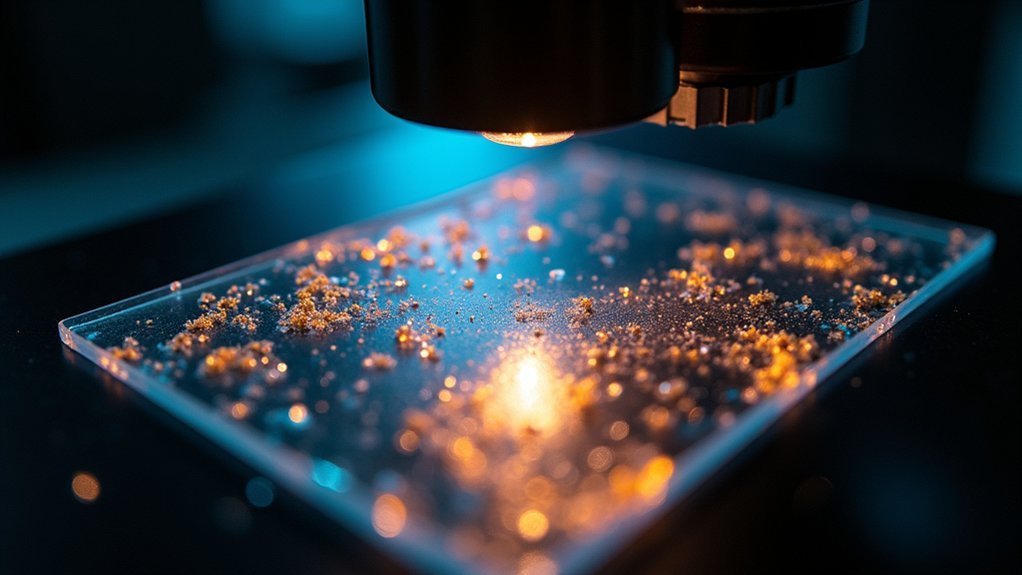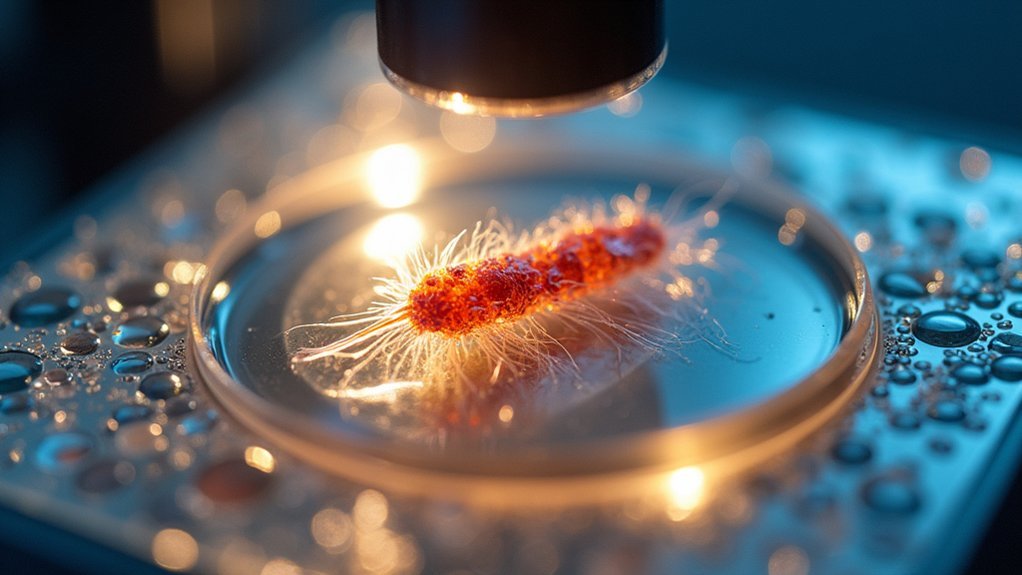Dark field microscopy fails when your condenser isn’t properly aligned, diaphragms are incorrectly set, or light intensity is insufficient. You’ll see oblong spots, poor contrast, and dim images when these elements aren’t optimized. Contaminated optical surfaces, improper specimen preparation, and air bubbles in immersion oil also disrupt the dark field effect. Regular alignment checks and proper technique guarantee successful imaging. The following troubleshooting guide will transform your dark field results.
9 Second-Level Headings for “What Makes Dark Field Imaging Fail To Work?”

Although dark field imaging can reveal intricate specimen details invisible in brightfield microscopy, several technical factors can cause this technique to fail completely.
When you’re troubleshooting these failures, consider examining five key areas that commonly undermine image quality.
First, check your condenser positioning and adjustment, as improper height or aperture settings create uneven illumination.
Second, evaluate your light path for missing diffusion filters that can cause visible lamp filament artifacts.
Third, assess your specimen thickness, which might prevent adequate light scattering.
Fourth, inspect all optical surfaces and slides for contamination that produces glare and reduces contrast.
Finally, verify the substage condenser setup, as insufficient light scattering leads to poor visualization of specimen edges and defects.
These technical issues often explain why dark field imaging doesn’t deliver the expected results.
Improper Condenser Alignment and Positioning
Your dark field imaging will fail if your substage condenser isn’t properly aligned, resulting in oblong light spots that distort your specimens.
You’ll need to adjust the condenser height while observing your sample, as incorrect positioning drastically reduces light collection and image contrast.
Don’t forget to set your field stop to the appropriate size and keep both condenser aperture and field diaphragms wide open to maximize light throughput for clear, high-contrast dark field images.
Subheading Discussion Points for Improper Condenser Alignment and Positioning
When the substage condenser is misaligned, dark field imaging fails to deliver its characteristic high-contrast images that make specimen details pop. In darkfield microscopy, even slight condenser misalignment restricts the scattered light that creates the bright specimen against the dark background.
You’ll notice several telltale signs of improper positioning: uneven illumination, oblong light spots, and poor contrast that obscures critical specimen features. If your field stop is too small or incorrectly centered, it’ll block essential scattered light from reaching the detector.
Similarly, a partially closed condenser aperture limits the scattered light needed for effective imaging.
To troubleshoot, regularly check your condenser height and make precise adjustments. Confirm the aperture remains wide open, and position your field stop appropriately.
These adjustments will help restore the clarity and contrast that make dark field imaging so valuable.
Incorrect Diaphragm Setting
The diaphragm setting in dark field microscopy serves as the critical gateway for light manipulation, often determining the success or failure of your imaging attempts.
When you’re dealing with an incorrect diaphragm setting, you’ll notice poor image contrast and reduced specimen visibility due to insufficient light reaching your sample.
For ideal dark field imaging, you’ll need to adjust both the condenser aperture and field diaphragm to be fully open, maximizing light collection.
You should also match the field stop size to your current objective—an improper size creates unwanted glare or diminishes image quality.
Remember that dark areas or oblong light spots in your viewfield indicate improper light focusing, often resulting from incorrectly positioned diaphragms.
Off-Center Light Path
Proper dark field illumination hinges critically on condenser alignment, as off-center light paths will compromise the striking contrast you’re trying to achieve. When your substage condenser isn’t properly positioned, light rays scatter unevenly across your specimen, creating dark spots or oblong illumination patterns.
| Problem | Solution |
|---|---|
| Misaligned condenser | Center using adjustment screws |
| Incorrect height | Raise/lower for ideal focus |
| Incomplete Newton rings | Realign condenser with optical axis |
| Uneven illumination | Open field and aperture diaphragms fully |
| Dark spots in viewfield | Check for debris and clean optical surfaces |
To correct off-center light paths, verify both diaphragms are wide open during initial setup. Then adjust the condenser height until you achieve uniform illumination across the entire field. Remember that regular alignment checks are essential—even slight shifts can degrade your dark field images substantially.
Insufficient Light Intensity and Path Obstructions
Achieving ideal dark field imaging requires sufficient light intensity to properly illuminate specimens. If you’re experiencing dim images, check your lamp voltage—it should be set at maximum 12 volts for peak illumination. Insufficient light intensity often results from voltage settings that are too low for effective dark field observation.
Physical obstructions in the light path can also compromise your imaging quality. Remove any unnecessary filters that might be reducing illumination. Ascertain your substage condenser is properly positioned and your field stop is appropriately sized.
For high numerical aperture condensers, maintain proper immersion contact to prevent light artifacts.
Don’t overlook dust or contamination on optical surfaces, particularly the objective front lens. These can create bright spots or glare that disrupt the dark background essential for clear specimen visualization.
Incorrect Specimen Preparation Techniques

Even with perfect optical setup, your dark field imaging can fail due to problems that occur before specimens ever reach the microscope stage.
Proper specimen preparation is critical for successful visualization, as errors in this process directly impact image quality.
Common preparation mistakes to avoid:
- Using specimens that are too thin, resulting in insufficient light scattering and poor contrast
- Mounting specimens without coverslips, allowing drift from currents that blur images
- Failing to properly stabilize specimens in mounting medium, causing movement artifacts
- Leaving specimens unstained when staining would improve light scattering properties
- Incorrect alignment of the specimen with the optical axis, which produces oblong light spots instead of crisp circular ones
These preparation issues can undermine even the most sophisticated dark field setup.
Objective and Numerical Aperture Mismatches
When you’re struggling with dark field imaging, a mismatched condenser-objective NA ratio often creates the most fundamental problems, as your condenser’s NA must exceed your objective’s NA to properly block direct light while capturing scattered light.
You’ll notice immediate degradation of your dark field effect if your aperture diaphragm isn’t sufficiently adjusted, causing direct light to contaminate your dark background.
Light path interference can further compromise your images, especially when using objectives designed for bright field applications that inadvertently block the scattered light you’re trying to capture.
Condenser-Objective NA Ratio
The cornerstone of successful dark field imaging lies in proper matching between condenser and objective numerical apertures. When your condenser-objective NA ratio is imbalanced, image quality deteriorates rapidly.
- Your condenser’s NA must match or exceed your objective’s NA to capture scattered light effectively.
- Higher NA condensers collect more light, revealing finer specimen details with enhanced contrast.
- A condenser with lower NA than your objective creates resolution loss and poor feature visibility.
- Careful alignment of both components guarantees ideal light path integration.
- Adjusting your condenser aperture size to complement the objective’s NA maximizes scattered light capture.
Maintaining the proper condenser-objective NA ratio isn’t just technical minutiae—it’s essential for visualizing small structures and surface defects.
Without this critical balance, you’ll struggle to achieve the striking contrast that makes dark field microscopy so valuable.
Insufficient Aperture Diaphragm
Many dark field imaging failures stem directly from aperture diaphragm settings that don’t align with your objective’s numerical aperture.
When you’re dealing with an insufficient aperture diaphragm, you’ll notice immediately degraded contrast and illumination, making it nearly impossible to visualize critical specimen edges and defects.
High NA objectives require larger aperture openings to capture necessary scattered light. Without this proper matching, your images will appear dim and lack detail.
Conversely, low NA objectives paired with improper aperture settings waste available light and compromise image quality.
Remember that dark field microscopy depends on precise alignment between the aperture diaphragm and the objective’s numerical aperture.
To enhance clarity and visibility of fine details, always adjust your aperture diaphragm size to match your specific objective’s specifications.
Light Path Interference
Precise alignment between your objective lens and condenser forms the cornerstone of successful dark field microscopy, yet mismatches in this critical relationship often sabotage image quality.
When your light source path encounters interference, the scattered light fails to reach your objective properly.
Common light path interference issues include:
- Numerical aperture (NA) mismatches between condenser and objective lens, preventing adequate light collection
- Improperly positioned condensers creating oblong light spots and reducing contrast
- Objectives not designed specifically for dark field failing to capture scattered light effectively
- Incorrect height adjustments disrupting the light path geometry
- Improper field diaphragm settings blocking critical illumination pathways
Resolving these interferences requires careful attention to component compatibility and precise alignment of your optical elements, ensuring the light source effectively illuminates your specimen from the correct angles.
Contamination Issues on Optical Surfaces
When impurities accumulate on optical surfaces, they become formidable obstacles to successful dark field imaging.
Even minor contamination can dramatically scatter light in unintended directions, creating oblong light spots and uneven illumination that disrupt the dark field effect.
You’ll notice reduced light transmission, poor image quality, and diminished contrast when dust or fingerprints mar your optical components.
These issues compound over time as contamination gradually accumulates on your system.
To restore peak performance, regularly inspect and clean your objective front lens and other optical surfaces using only optical-grade tissue or cotton.
If you’re still experiencing issues, try incorporating a diffusion filter in the light path to distribute illumination more evenly, helping to minimize the visibility of contamination artifacts across your field of view.
Oil Immersion Problems and Air Bubble Formation

Although oil immersion techniques enhance resolution in dark field microscopy, they’re particularly susceptible to air bubble formation that can severely compromise image quality.
When you’re using oil immersion techniques, air bubbles trapped between the oil and objective lens scatter light unpredictably, undermining the entire imaging process.
- Bright spots in your viewfield often indicate trapped air bubbles
- Remove your eyepiece or use a Bertrand lens to check for bubbles
- Break oil contact completely when bubbles are detected
- Clean residual bubbles with a cotton swab before reapplication
- Apply only the necessary amount of oil—excess creates its own problems
Proper oil application is critical for successful dark field imaging.
If you notice resolution loss or unusual light patterns, examine your immersion medium for bubbles and reapply oil correctly to restore ideal imaging conditions.
Field Diaphragm Sizing and Adjustment Errors
The field diaphragm’s proper adjustment stands as one of the most frequently overlooked aspects of dark field microscopy. When you incorrectly size this important component, you’ll immediately notice poor contrast and inadequate illumination that obscures critical specimen details.
Proper field diaphragm adjustment is essential—neglect it and watch your dark field images suffer from compromised contrast and visibility.
Watch for oblong light spots or dark patches in your viewfield—these indicate your condenser isn’t properly aligned with the optical path. You’ll need to verify your field diaphragm sizing aligns with the numerical aperture of your objective; misalignment greatly reduces image quality.
To optimize your dark field imaging, set the diaphragm to suppress glare while enhancing background contrast. This balance is vital for observing fine specimen details.
Make checking and adjusting the field diaphragm part of your regular workflow, especially when changing specimens or imaging conditions.
Specimen Drift and Mounting Medium Concerns

Maintaining specimen stability presents considerable challenges during dark field microscopy, particularly as water currents in your mounting medium can cause frustrating drift.
To minimize specimen drift and achieve clearer imaging results, consider these critical factors:
- Use a thicker mounting medium to stabilize specimens
- Always include a coverslip to restrict specimen movement
- Secure the coverslip properly during preparation
- Be aware of action currents caused by evaporation at coverslip edges
- Prepare specimens methodically for optimal stability
When you neglect these mounting considerations, even the best dark field setup will produce disappointing results.
The subtle movements caused by liquid currents can blur your observations and compromise image quality.
Frequently Asked Questions
What Are the Problems Associated With Dark Field Microscopy?
Your dark field microscopy problems include misaligned condensers, incorrect field stops, thick specimens, optical surface contamination, and missing diffusion filters. These issues can severely compromise your image quality and specimen visibility.
What Is the Primary Principle Behind the Functioning of a Dark Field Microscope?
The primary principle behind dark field microscopy is that you’re only collecting scattered light from your specimen while blocking direct light. This creates a bright image against a dark background, enhancing contrast considerably.
What Is the Resolution Limit of a Dark Field Microscope?
The resolution limit of your dark field microscope is typically around 200 nanometers, depending on your objective’s numerical aperture (0.1-1.4) and the wavelength of light you’re using. It’s limited by light’s diffraction properties.
How Could a Microscope Field That Was Too Dark Be Corrected?
You’ll need to increase your lamp voltage up to 12 volts, adjust the condenser height, fully open both diaphragms, clean all optical surfaces, and verify field stop size matches your objective.
In Summary
You’ll find that most dark field imaging failures stem from technical errors you can correct with practice. Check your condenser alignment, light intensity, specimen preparation, and objective selection regularly. Don’t overlook contaminated surfaces or improper oil immersion techniques. By systematically addressing these common issues, you’ll transform frustrating failures into consistently stunning dark field images that reveal previously invisible specimen details.





Leave a Reply